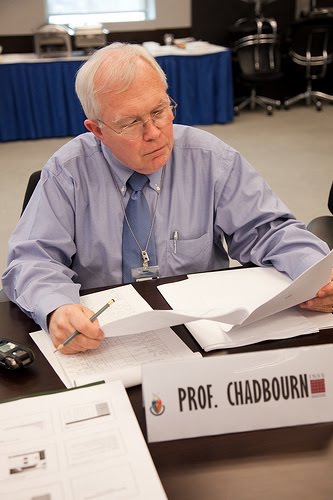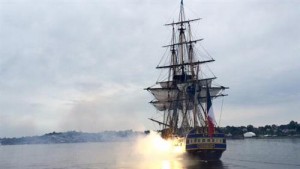 In the summer of 2015, l’Hermione, a beautifully reconstructed replica of an 18th century, three-masted, 32-gun, Concorde class French frigate visited ports on the east coast of North America from Yorktown, Virginia, to Lunenberg, Nova Scotia. Her namesake vessel gained fame in 1780 by ferrying the Marquis de Lafayette to America with secret news that King Louis XVI of France was sending much-needed military support in the form of a half-dozen naval ships and 5,500 troops under the command of Comte de Rochembeau to assist the American colonies in their revolt against Britain. This military assistance would prove critical to the eventual Franco-American victory at Yorktown the following year. The original l’Hermione was wrecked in heavy seas in 1793 after running aground on the rugged coast off Le Croisic in the Loire-Atlantique department of western France. Two centuries later, reconstruction of l’Hermione at Rochefort, France, would be possible only because the British Admiralty, recognizing the superior design of the vessel, had preserved blueprints in their archives of her sister ship captured during the wars between France and England.
In the summer of 2015, l’Hermione, a beautifully reconstructed replica of an 18th century, three-masted, 32-gun, Concorde class French frigate visited ports on the east coast of North America from Yorktown, Virginia, to Lunenberg, Nova Scotia. Her namesake vessel gained fame in 1780 by ferrying the Marquis de Lafayette to America with secret news that King Louis XVI of France was sending much-needed military support in the form of a half-dozen naval ships and 5,500 troops under the command of Comte de Rochembeau to assist the American colonies in their revolt against Britain. This military assistance would prove critical to the eventual Franco-American victory at Yorktown the following year. The original l’Hermione was wrecked in heavy seas in 1793 after running aground on the rugged coast off Le Croisic in the Loire-Atlantique department of western France. Two centuries later, reconstruction of l’Hermione at Rochefort, France, would be possible only because the British Admiralty, recognizing the superior design of the vessel, had preserved blueprints in their archives of her sister ship captured during the wars between France and England.
Archives are indispensable for providing the lifeblood of primary source materials and other documents which are so essential to serious historical inquiry and study. In this edition of IJNH we introduce a new series of articles called “Inside the Archives” as the first of what we hope will become a regular feature in the future. The intent of these articles is to focus a spotlight on and to share information about archival holdings of interest to Naval Historians. We begin by examining the Special Collections of the Dudley Knox Library at the U.S. Naval Postgraduate School in Monterey, California. The Head of Special Collections Section, John Sanders, offers a brief glimpse of the fascinating Yangtze River Patrol Collection in the Knox Library which provides insight into American Naval activity in China at the turn of the 20th Century. We invite Archivists, Librarians, and Scholars to submit their own candidates for inclusion in this series.
Also in this issue, Corbin Williamson of Ohio State University analyses conflict and cooperation in Anglo-American naval relations in the spring of 1941. His article examines “debates over warship deployments and repair work that occurred as part of the ABC-1 military staff talks in Washington.” Williamson contends that historians have not given adequate attention to the role of industrial facilities, including shipyards and dry docks, “in shaping the development of Anglo-American relations during the Second World War.” He attempts to address that oversight in this article. Williamson concludes that the ABC-1 agreement was one of the first instances in Anglo-American military relations in which growing American naval strength “played a significant role in shaping the outcome.”
Just over 70 years ago heavy American involvement in the Vietnam conflict was initiated under President Lyndon Johnson. Appropriately enough we have included two articles on the Vietnam War in this issue. In the first article Dr. Nathan Packard examines the U.S. Marine Corps’ search for relevancy and modernization during the years of the Carter Administration, an era that proved to be critical for the Corps. A more extensive examination of this topic will be forthcoming in a monograph to be published by the University of North Carolina Press under sponsorship of the Society of Military History. In the second article we continue our commitment to encouraging scholarship by junior members of the profession. Again we are publishing an article drawn from entries to the annual National History Day competition in College Park, Maryland, a documentary entitled “USS KIRK: Leadership Amidst Chaos, a Legacy of Survival.” Author Abigail Wiest tells the story of a U.S. Navy destroyer escort that played a central role in the rescue of many South Vietnamese military members and their families fleeing Communist forces at the end of the Vietnam War. This article makes an original contribution to knowledge of the tragic ending of the war in Vietnam through capturing the voices of former Vietnamese officers who played key roles in the drama that was the fall of Saigon. We decided to include the extensive annotated bibliography prepared for this documentary, not only because of the quality of the scholarship, but because of what it adds to our knowledge of the subject matter as well.
Much of the scholarly debate on the Royal Navy mutinies of 1797 has revolved around actions at Spithead, the Nore, and Yarmouth, with a cursory nod to the later mutinies that occurred in the Mediterranean, the West Indies, and Simon’s Bay and Table Bay at the fledgling British Cape Colony. Allison Funk rectifies this shortcoming in her article through analysis of the events at the Cape. In the process she offers us valuable insights not only into the epidemic potential of mutiny, but the British sailor as well.
We have two important personnel announcements. First, Dave Colamaria is stepping down as Digital Editor of IJNH due to the increasing demands of his position with the photo archives of Naval Heritage and History Command. Dave has been instrumental to the revitalization of this journal over the last two years. Quite frankly, without him it would not have happened. Matthew (Matt) Eng, Digital Content Developer at the Naval Historical Foundation will be our new Digital Editor. Also, Elizabeth Williams is joining our staff as Executive Assistant to the Editor.
Comments, suggestions, ideas, and potential articles for these pages are always welcome. Such dialog is productive in the development of historical knowledge on the important roles played by maritime forces.
Dr. Charles C. Chadbourn, III
Editor, International Journal of Naval History
Professor of Strategy, U.S. Naval War College
(Return to the July 2015 Table of Contents)

